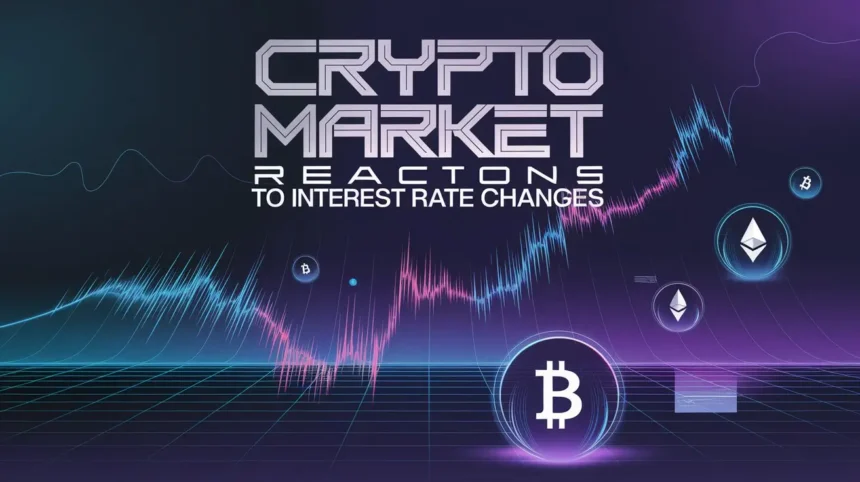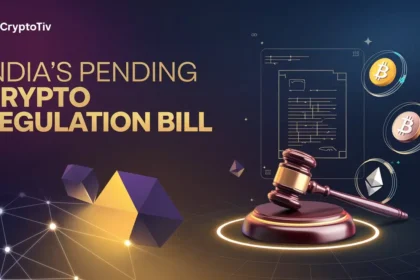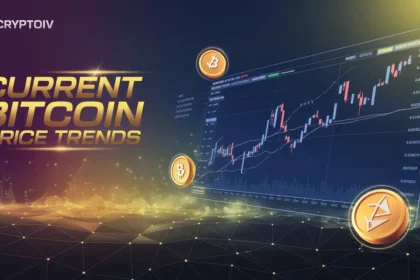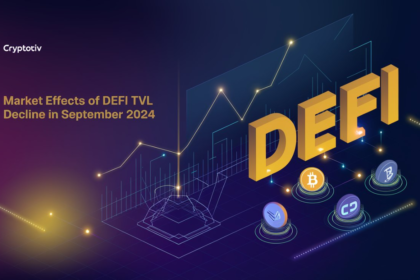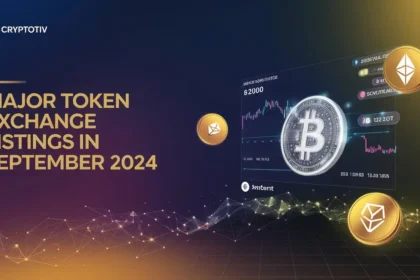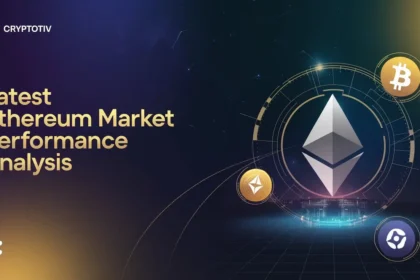The crypto market’s reactions to interest rate changes by central banks, particularly the Federal Reserve, are crucial for investors, traders, and financial analysts. Interest rate changes can significantly impact market behavior, leading to immediate price volatility and influencing market trends. Recent Federal Reserve decisions have shown a direct link between interest rate announcements and short-term market movements in cryptocurrencies. Understanding these market responses is essential for navigating the ever-changing crypto landscape.
Immediate Market Response to Federal Reserve Rate Changes
When the Federal Reserve announces an interest rate change, the crypto market’s response is often swift and significant. Cryptocurrencies are known for their volatility, and rate changes tend to amplify this characteristic, causing rapid fluctuations in prices and trading volumes. In the moments following a Federal Reserve decision, investors closely monitor market conditions to gauge the immediate impact on major cryptocurrencies like Bitcoin and Ethereum. This section delves into these short-term market responses, highlighting how rate changes can trigger immediate shifts in market dynamics.
Bitcoin’s Price Volatility Post-Rate Announcement
Bitcoin, as the leading cryptocurrency, often experiences the most pronounced volatility in response to Federal Reserve interest rate changes. When the Fed signals a rate hike, Bitcoin’s price tends to react swiftly, often with sharp declines as investors move towards safer assets due to the interest rate impact on the overall economy. For instance, Bitcoin saw a steep drop in 2018 when a series of rate hikes were introduced, correlating with a broader decline in the crypto market. Conversely, rate cuts have historically led to immediate price surges.
Note
In March 2020, when the Fed slashed rates to near zero, Bitcoin’s price surged by 200% over the year, showcasing its sensitivity to monetary policy shifts.
Altcoins and Rate Sensitivity
Altcoins often mirror Bitcoin’s behavior but with heightened sensitivity. When the Federal Reserve announces rate hikes, altcoins typically experience amplified volatility compared to Bitcoin. This is due to their lower market caps and higher speculative nature, making them more susceptible to sudden market shifts. For example, following recent Federal Reserve announcements, coins like Solana, Cardano, and Ethereum showed significant price swings. While Bitcoin may drop 5%, some altcoins could decline by 10% or more, reflecting their rate change effects. However, during rate cuts, altcoins often exhibit even sharper upward movements, benefiting from increased liquidity and risk-on market sentiment.
| Altcoin | Price Change Post-Rate Hike (2024) | Price Change Post-Rate Cut (2020) |
|---|---|---|
| Solana | -12% | +35% |
| Ethereum | -8% | +25% |
| Cardano | -10% | +30% |
Impact on Stablecoins and Market Liquidity
Interest rate changes also have a notable effect on stablecoins and overall market liquidity. Stablecoins such as USDT, USDC, and DAI often serve as safe havens during periods of volatility triggered by rate hikes. When the Federal Reserve raises rates, investors tend to increase their stablecoin holdings, seeking refuge from the volatility in Bitcoin and altcoins. This behavior can lead to a temporary increase in stablecoin market cap and trading volumes. Furthermore, interest rate hikes can reduce overall crypto market liquidity as traders become more risk-averse. Conversely, rate cuts can encourage investors to move from stablecoins into more volatile assets, increasing liquidity and trading volumes in the broader market.
Crypto Market Dynamics During Rate Hike Cycles
In periods of consistent rate hikes by the Federal Reserve, the crypto market undergoes noticeable changes. These cycles lead to shifts in investor sentiment, trading behaviors, and overall market trends. As the cost of borrowing increases, investors often reassess their risk exposure, leading to a domino effect across different sectors of the crypto market. This section delves into how rate hike cycles influence market behavior, liquidity, and trading volumes, providing a comprehensive overview of the crypto market dynamics during such periods.
Investor Sentiment in Crypto After Rate Hikes
Investor sentiment in the crypto market often turns risk-averse during rate hike cycles. As the Federal Reserve raises interest rates, the appeal of high-risk assets like cryptocurrencies typically diminishes. Investors seek safer alternatives, such as government bonds, due to their lower risk profile. This shift often results in a market-wide sell-off, leading to significant price corrections.
For example, during the 2022 rate hike cycle, Bitcoin and other major cryptocurrencies experienced sharp declines as investors moved their capital into more stable asset classes. Market sentiment indicators, such as the Crypto Fear and Greed Index, often show heightened fear during these periods, reflecting the cautious stance of the market. Additionally, heightened interest rates can lead to a decrease in liquidity, further fueling market corrections as selling pressure intensifies.
Effect on DeFi Protocols and Liquidity Pools
Decentralized finance (DeFi) protocols are particularly vulnerable during rate hike cycles. Rising interest rates impact DeFi activities such as yield farming and liquidity provision. Higher rates in traditional markets make the risk-adjusted returns in DeFi less attractive, prompting investors to withdraw their capital from these protocols. As a result, the liquidity pools on platforms like Uniswap, Aave, and Compound often see a reduction in available liquidity.
This outflow can lead to increased volatility within DeFi markets, making them less stable and more prone to sudden price swings. Additionally, with reduced liquidity, the cost of executing large trades increases, which can exacerbate market declines. The diminished activity in DeFi during rate hike cycles also highlights the interconnectedness between traditional financial markets and the crypto ecosystem.
Trading Volumes and Market Capitalization Trends
Rate hikes directly influence trading volumes and overall market capitalization within the crypto space. Typically, rate change effects lead to decreased trading activity on major exchanges as investors adopt a more cautious stance. The higher borrowing costs reduce the appeal of leveraged trading, resulting in lower volumes across both spot and derivatives markets. According to recent data, trading volumes on major exchanges like Binance and Coinbase experienced a noticeable decline during the 2022 rate hike cycle. Consequently, this decline in trading activity often leads to a reduction in the overall crypto market capitalization.
Key Changes Observed Post-Rate Hikes
- Decline in Trading Volumes: Reduced market activity as investors move to less volatile assets.
- Decreased Market Capitalization: Lower market cap due to widespread sell-offs.
- Reduced Liquidity: Impact on liquidity in both centralized exchanges and DeFi protocols.
- Lower Leverage: Diminished use of leverage in trading due to increased borrowing costs.
Crypto Market Response to Interest Rate Cuts
Interest rate cuts by the Federal Reserve typically lead to a more favorable environment for the cryptocurrency market. Lower interest rates reduce the cost of borrowing, encouraging investors to take on more risk and seek higher returns in assets like cryptocurrencies. This section explores how the crypto market generally responds to rate cuts, often resulting in immediate price surges, increased liquidity, and heightened trading activity.
Short-Term Crypto Price Surges
One of the most immediate responses to an interest rate cut is a surge in crypto prices. When the Federal Reserve lowers rates, the cost of borrowing decreases, and investors often seek out higher-yielding investments, including cryptocurrencies. For instance, during the rate cuts in March 2020, Bitcoin and other major altcoins experienced significant price increases.
Bitcoin’s value surged by approximately 200% by the end of 2020 following the rate cuts, showcasing its sensitivity to monetary easing. Similarly, altcoins like Ethereum and Cardano also saw substantial gains during this period. These price surges can be attributed to the influx of capital into the market, as investors move away from low-yielding traditional assets and into riskier, high-reward markets.
Increased Market Liquidity and Exchange Volumes
Interest rate cuts also lead to increased market liquidity and higher trading volumes on crypto exchanges. Lower rates make borrowing cheaper, encouraging traders to leverage their positions and increase their exposure to the market. This activity often results in a surge in trading volumes across major exchanges. For example, during periods of monetary easing, exchanges like Binance and Coinbase have reported increased trading volumes, with more market participants taking advantage of the favorable conditions. Additionally, the influx of new capital into the market enhances liquidity, making it easier for investors to execute large trades without significantly impacting prices. This increased liquidity contributes to a more dynamic market environment, facilitating short-term trading and price discovery.
Enhanced Risk Appetite Among Crypto Investors
Rate cuts foster a greater appetite for risk among investors, prompting them to explore higher-yielding opportunities in the crypto market. With traditional investments like government bonds offering lower returns, investors are more willing to allocate capital to riskier assets, including Bitcoin, altcoins, and DeFi tokens. This increased risk tolerance often results in a bullish market sentiment, leading to rallies across the crypto spectrum.
Furthermore, the reduced opportunity cost of holding riskier assets encourages long-term investors to enter or increase their positions in the crypto market, contributing to overall market growth. Enhanced risk appetite is often reflected in the growth of speculative assets and newer market segments, such as NFTs and yield farming protocols.
Central Bank Decisions and Crypto Market Volatility
Central bank decisions, including unexpected interest rate changes, can cause significant volatility in the cryptocurrency market. The uncertainty surrounding these decisions often leads to rapid price swings, affecting both crypto prices and trading behaviors. This section analyzes how speculation and announcements from central banks, particularly the Federal Reserve, contribute to short-term market volatility.
Volatility Spikes Following Rate Announcements
Unexpected interest rate changes frequently trigger sharp volatility spikes in the crypto market. When the Federal Reserve announces a rate change that diverges from market expectations, cryptocurrencies often experience sudden and substantial price swings. For example, during periods of unexpected rate hikes, Bitcoin and altcoins have shown significant downward price movements as investors react to the news by selling off riskier assets. Conversely, unexpected rate cuts can lead to immediate rallies in crypto prices, as seen in March 2020, when the total crypto market cap surged following an emergency rate cut by the Fed. These volatility spikes reflect the market’s sensitivity to monetary policy shifts, with traders adjusting their positions in response to changing economic conditions.
Correlation Between Interest Rates and Crypto Market Movements**
There is a discernible correlation between changes in interest rates and movements in the cryptocurrency market. Historically, periods of rising interest rates have coincided with bearish trends in the crypto market, as higher rates reduce the appeal of high-risk investments. Conversely, rate cuts are often correlated with bullish market phases, where the availability of cheaper capital encourages investment in riskier assets like cryptocurrencies. The correlation is particularly evident when analyzing the behavior of Bitcoin and major altcoins, which tend to exhibit higher volatility around rate change announcements. A correlation table examining historical data between interest rate changes and crypto market movements would highlight these trends, showing patterns of increased volatility and trading volume in response to rate decisions.
| Interest Rate Change | Bitcoin Movement | Altcoin Movement |
|---|---|---|
| Rate Hike | Bearish | Increased Volatility |
| Rate Cut | Bullish | Price Surge |
Impact on Crypto Market Sentiment
Market sentiment in the crypto space is highly responsive to central bank decisions. When the Federal Reserve signals a hawkish stance, indicating potential rate hikes, market sentiment often shifts towards caution. This shift is usually reflected in a sell-off of riskier assets and a subsequent decline in market prices. Sentiment indicators like the Crypto Fear and Greed Index tend to lean towards “fear” during these times, indicating a risk-averse market stance.
On the other hand, dovish signals from the Fed, such as rate cuts or a pause in rate hikes, can quickly alter market sentiment to a more bullish outlook. This sentiment change often leads to a surge in trading activity, with investors exhibiting a renewed appetite for risk, prompting rallies in both Bitcoin and altcoins.
Market Insights for Crypto Investors During Rate Changes
Central bank rate shifts significantly influence crypto market behavior. Investors need to stay alert to how these shifts impact market trends, trading volumes, and investor sentiment.
Short-Term Trading Insights After Rate Changes
Short-term traders often react quickly to rate decisions. Speculation around potential cuts can lead to heightened trading activity, as traders anticipate market rallies. For instance, periods of rate cut speculation have triggered notable inflows into crypto markets, reflecting a risk-on sentiment. Conversely, when hikes are anticipated, traders may adopt a more cautious approach, leading to increased short-selling. Monitoring key indicators like the Consumer Price Index (CPI) is crucial for anticipating market movements and adjusting strategies accordingly.
Understanding Market Dips and Surges
Announcements often lead to immediate market volatility. Hikes typically trigger sell-offs, as investors seek to hedge against potential declines in liquidity and higher borrowing costs. Conversely, rate cuts can cause market surges due to lower borrowing costs and increased investor appetite for riskier assets. Staying attuned to real-time market trends helps investors capitalize on rapid price changes, presenting both opportunities and challenges in the crypto landscape.
Related Topics for Further Reading
- Current Bitcoin Price Trends
- Impact of US Inflation Data on Crypto
- Market Effects of DeFi TVL Decline
- Federal Reserve’s Crypto Regulatory Stance
- Market Sentiment Analysis
Interest rate changes by central banks, particularly the Federal Reserve, play a pivotal role in shaping the cryptocurrency market. Immediate market responses often manifest as sharp price fluctuations, reflecting the crypto market’s sensitivity to rate hikes and cuts. Rate hike cycles tend to drive risk-averse behavior, leading to market corrections and reduced liquidity in areas like DeFi. Conversely, rate cuts usually result in price surges and increased market activity as investors seek higher returns. Understanding these dynamics helps investors navigate the volatile crypto landscape, highlighting the importance of real-time monitoring and informed trading strategies. As central bank policies continue to evolve, staying attuned to these changes remains crucial for market participants.



